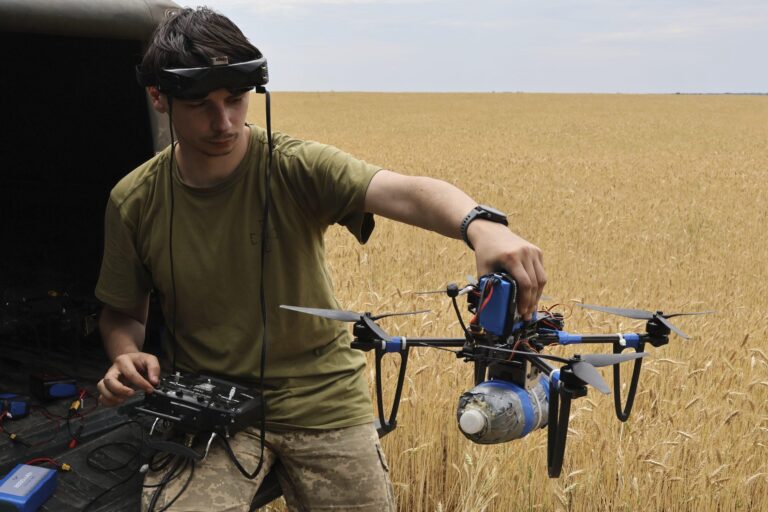A sudden surge in Ukrainian drone activity has thrown Russian air travel into turmoil, disrupting schedules and grounding flights across key routes. According to reports from Radio Free Europe/Radio Liberty, the coordinated drone strikes and reconnaissance missions over Russian territory have forced authorities to impose emergency measures, highlighting the escalating tensions and the far-reaching impact of the ongoing conflict. This latest development underscores the growing role of unmanned aerial vehicles in modern warfare and their ability to directly affect civilian infrastructure.
Ukrainian Drone Attacks Disrupt Russian Air Travel and Complicate Military Logistics
Recent Ukrainian drone operations have severely impacted Russian air travel, forcing numerous flight cancellations and causing significant scheduling chaos at key airports. Reports indicate that the persistent use of small, agile drones has not only grounded civilian flights but also crippled military supply routes vital for Russian operations in contested regions. The interruptions have led to increased scrutiny of Russia’s air defense systems, highlighting vulnerabilities in dealing with low-signature aerial threats.
Experts emphasize that these drone strikes serve a dual purpose:
- Disrupting logistical chains: Ukrainian forces target cargo hubs and transit points critical for the movement of troops and equipment.
- Forcing costly operational adjustments: Russian authorities are reallocating resources to bolster airspace security, stretching their capacity thin.
| Impact Area | Effect | Response |
|---|---|---|
| Military Airfields | Delayed supplies and reinforcements | Heightened drone patrols |
| Civilian Airports | Flight cancellations and passenger delays | Increased security screenings |
| Transport Networks | Disrupted cargo deliveries | Rerouted logistics corridors |
Impact on Russian Civilian Air Traffic and Regional Security Measures
The recent surge in Ukrainian drone attacks has prompted significant disruptions in Russian civilian air travel, with multiple airports experiencing sudden closures and rerouted flights. Airlines have reported numerous cancellations as security protocols intensify, impacting both domestic and international routes. Passengers face longer wait times and uncertainty as orders to reduce air traffic over sensitive regions are enforced. Air traffic controllers have been placed on high alert, elevating security checks and implementing no-fly zones to mitigate the risk of drone-related incidents near flight paths.
Regional authorities have also escalated ground security measures to complement aerial defenses. This includes:
- Heightened patrols around critical infrastructure such as airports and communication hubs
- Deployment of advanced radar systems capable of detecting low-flying drones
- Collaborative drills between civil aviation and military forces to ensure rapid response
Below is a snapshot of recent disruptions recorded at major Russian airports over the past week:
| Airport | Flight Cancellations | Security Alerts | Operational Status |
|---|---|---|---|
| Domodedovo International (Moscow) | 56 | 3 | Limited Ops |
| Koltsovo Airport (Yekaterinburg) | 24 | 2 | Reduced Flights |
| Pulkovo Airport (St. Petersburg) | 38 | 4 | Normal Ops |
Recommendations for Enhancing Airspace Defense Against Emerging Drone Threats
To effectively counter the increasing use of drones in modern warfare, airspace defense systems must evolve rapidly. Integrating multi-layered detection technologies, including radar, infrared sensors, and radio frequency tracking, can create a comprehensive network capable of identifying and neutralizing low-flying, small-profile aerial threats. Additionally, employing AI-driven threat assessment tools enhances real-time decision-making, allowing operators to distinguish between hostile drones and civilian or commercial UAVs with greater accuracy.
More proactive strategies also involve strengthening cross-sector collaboration between military forces, aviation authorities, and private drone manufacturers. Establishing clear protocols for communication and response coordination during drone-related incidents reduces confusion and mitigates air travel disruption. The table below summarizes core defensive tactics currently recommended for airspace protection against emerging drone challenges:
| Defensive Measure | Function | Benefits |
|---|---|---|
| Radar & RF Monitoring | Detect drones at various ranges | Early warning, broad coverage |
| AI Threat Analytics | Classify targets in real-time | Minimizes false alarms |
| Jamming & Electronic Warfare | Disrupt drone control signals | Non-lethal neutralization |
| Legal & Regulatory Frameworks | Standardize drone operations | Reduce unauthorized flights |
Final Thoughts
As the Ukrainian drone campaign continues to disrupt Russian air travel, the evolving conflict underscores the growing role of unmanned technology in modern warfare. The sustained pressure on Russia’s aviation infrastructure not only hampers military logistics but also sends a clear message about Ukraine’s resilience and tactical innovation. Observers will be closely watching how these developments impact the broader dynamics of the conflict in the weeks ahead.




